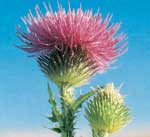Plumeless thistle
Carduus acanthoides L.
Keys to Identification
- Plumeless thistle can be distinguished from musk thistle by the leaf-like spines on the stem, and hairs on the underside of the leaf
- Plumeless thistle flower heads are 1-2 in wide, about one-third the size of musk thistle flower heads
This information courtesy of the Colorado Natural Areas Program
Family
Sunflower (Asteraceae)
Other Names
Bristly thistle, spiny plumeless thistle.
USDA Code
CAAC
Legal Status
Colorado Noxious Weed List B
Identification
Lifecycle
Winter annual or biennial.
Growth form
Forb
Flower
Flower heads are solitary at the ends of branches or in clusters of 2-5. Flower bracts are narrowly lance-shaped and appear as sharp spines. Flowers are purplish-pink and clustered in heads that are 1-2 in wide.
Seeds/Fruit
One-seeded fruit (achene), capped by a ring of bristles.
Leaves
Basal rosette leaves are usually 4-8 in long with spiny lobes. Stem leaves alternate, stalkless, hairy underneath, and blending into the stem.
Stems
Mature plants are between 1-4 ft tall. Stems are freely branched above and covered with leaf-like spines that extend up to the flowering heads (Whitson et al. 1996).
Roots
Thick, fleshy taproot.
Other
Closely related to musk thistle(Carduus nutans).
Similar Species
Exotics
Plumeless thistle is similar to musk thistle. Rosettes of plumeless thistle are distinguished from those of musk thistle by having leaves that are deeply serrate (saw-toothed) almost to the midrib.
Natives
There are many native thistle species (in the genusCirsium). The natives generally do not have leaves clasping the stem all the way from node to node (strongly decurrent leaves), and many have hairy upper and lower leaf surfaces and are blue-green or gray in color.
Impacts
Agricultural
Plumeless thistle is unpalatable to livestock; large infestations may reduce available forage.
Ecological
Plumeless thistle does not typically pose a threat to high quality natural areas, although it has been known to invade native and restored grasslands despite the presence of dense, native prairie vegetation (Wisconsin DNR 1998). This species is highly aggressive in disturbed areas, and can pose a major problem in buffer and restoration areas (Wisconsin DNR 1998). Plumeless thistle is one of the most aggressive thistles due to its large seed production (Feldman 1997).
Habitat and Distribution
General requirements
Plumeless thistle is locally abundant in pastures, stream valleys, fields, and along roadsides.
Distribution
Plumeless thistle is frequently found in Colorado and has the potential of becoming a widespread noxious weed. Plumeless thistle is especially problematic on the Great Plains and in mesic pastures of the Intermountain West.
Historical
Native to Eurasia.
Biology/Ecology
Life cycle
Seedlings emerge from early spring to late fall and the length of time to flowering can vary from 4 to 22 months (Wisconsin DNR 1998). A single taproot is formed and stem elongation takes place in early May. Flowering begins in early June and continues until mid-August (Wisconsin DNR 1998).
Mode of reproduction
Seed.
Seed production
A single plant is capable of producing up to 9,000 seeds.
Seed bank
90-95% of seeds produced may germinate under favorable conditions (Wisconsin DNR 1998, Feldman 1997). Seeds can remain viable in the soil for up to 10 years (Wisconsin DNR 1998).
Dispersal
Seeds are mainly dispersed by wind.
Hybridization
May hybridize with musk thistle(Carduus nutans).
References
Feldman, S.R. 1997. Biological control of plumeless thistle (Carduus acanthoides L. in Argentina. Weed Science, 45:534-537.
Whitson, T.D.(ed.), L.C. Burrill, S.A. Dewey, D.W. Cudney, B.E. Nelson, R.D. Lee, R. Parker. 1996. Plumeless thistle. Weeds of the West. Western Society of Weed Science, in cooperation with the Western United States Land Grant Universities Cooperative Extension Services, Newark CA. pg. 74.


